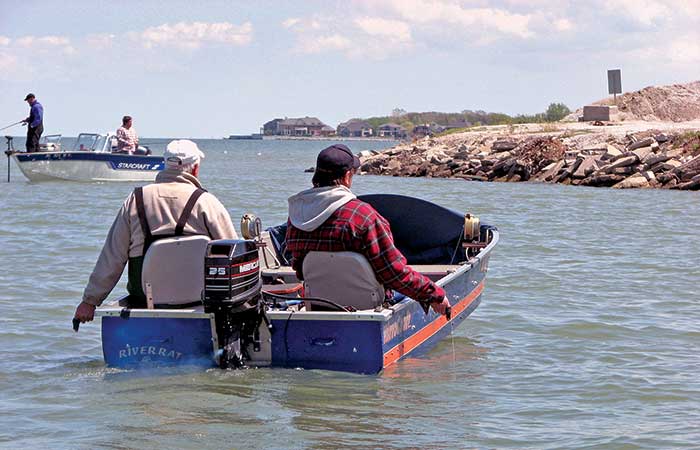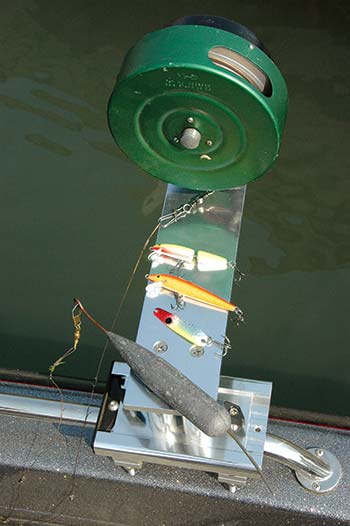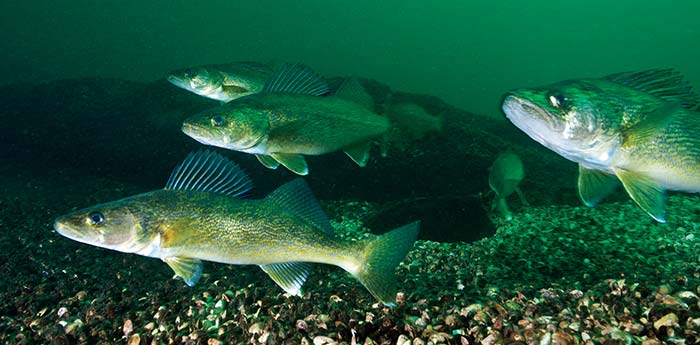Advertisement
In pursuit of a tasty native fish that thrives in snag-infested waters, Great Lakes anglers created a rod-free form of trolling for dinner.

April and May are prime months for employing the distinctive handline technique for catching Detroit River walleye. (Photo: Per Verdonk)
The Detroit River flows 28 miles from Lake St. Clair to Lake Erie, supplying about 90% of the water in the smallest Great Lake. The relatively narrow river (half-mile wide on average), with its deep trough and powerful current, serves as the conduit for the outflow from the upper Great Lakes that attracts pre-spawn walleye by the millions each spring. Motor City anglers learned long ago there's nothing conventional about hooking these popular gamefish that some folks consider the inland sea's best-tasting catch.
Each spring, in boats large and small, fishermen flock to the waterway separating Ontario and Michigan, dodging oceangoing freighters and battling changing currents to drop baits into the structure 35 to 50 feet below. Their offerings must negotiate an underwater gauntlet of humps, caves, and more than a few motor vehicles that have been deep-sixed over the decades. Old-time anglers claim that migrating walleye dodge the river's current by holding deep, often hiding behind abandoned railroad boxcars, cars, and trucks ditched in the depths, as well as boulders and scour-holes. As counterintuitive as it seems, walleye anglers actually seek out such snag-infested waters to lure their quarry into a strike.

How We Got Here
More than a century ago, the nagging snagging problem prompted some resourceful anglers to adopt a more hands-on approach. Literally. They realized the drop-offs, snags, and other walleye-holding structures hindered traditional trolling methods with conventional rods, reels, and lines, so they improvised. The result has become known as "handlining," a tactic developed by Detroit-area anglers targeting walleyes that hug the bottom as they negotiate the flow.
"In the Detroit River in the spring, you'll see more boats sprouting handline reels than traditional fishing rods by two to one," says veteran walleye angler and handline advocate Gary "Bo" Bowman of Westland, Michigan. "When the water's muddy and moving, handlining is hands-down the most productive method for catching walleye."
Pioneers of the fishing method pirated parts from hand-cranked Victrola phonograph players to assemble spring-loaded reels capable of handling the weights and wire line the slow-trolling technique required. These anglers clamped the reels on the gunwales of their fishing boats, paying out the cable, working the baits by hand, and hoisting in their catch hand over fist.
Since those early days, the specialized tackle and technique have morphed into a rod-free method now practiced by spring walleye anglers in the larger river systems throughout the Upper Midwest. But nowhere is handlining as common as on the river that drains lakes Huron and St. Clair, and no time more often than the months of March through May.
Warning: Veteran handliners, some of whom have missing digits to prove their point, warn new handliners against succumbing to the temptation to wrap wire around their fingers or hands while fishing. They also recommend wearing gloves or rubber or leather guards on the fingers of their fishing hands to absorb the wear and tear that even the plastic-coated cable can impart to unprotected fingers.
Keep It Reel

The terminal end of a traditional handline rig, with the weight
trailing a 'shank' of line attached to a lure. (Photo: Dan Armitage)
The heart of the handline system is the single-action level-wind reel design with a spring-loaded spool built to hold — and automatically retrieve — at least 200 feet of 60-pound test that is braided and coated seven-strand wire. The reel is mounted amidships on the gunwale of the boat, usually in pairs, one to a side. The reels come with mounting hardware to clamp them to the gunwale or handrail, drop into a rod holder base, or slip into a track affixed atop the gunwale. This allows the reels to be removed when the technique isn't being used.
At one time, there were several manufacturers offering handline reels, all based in Michigan. Today the market is dominated by two: the Kachman model made by Riviera Trolling Systems of Port Austin, and the A&S model made by A&S Manufacturing in Ecorse.
The Kachman reel, made from Lexan and stainless steel, is 6.5 inches in diameter, about 3 inches thick, has a capacity of 200 feet of 60-pound-test braided wire, and weighs about 3 pounds with the mounting hardware. The A&S reel, built from aluminum and steel, is similar in size with a 300-foot capacity. It weighs about 6 pounds, including the included C-clamp. The reels' release tension and clutch functions are fully adjustable and preset for common fishing conditions. This allows them to pay out wire to the pull of a 1-pound weight, and to retrieve wire when that tension is relieved by the angler. Both reels have a dedicated following among hardcore handliners and retail for about $250 to $300 spooled with wire and including mounting hardware. You can often find new and vintage handline reels on eBay for half that.
The shank is a 4- to 5-foot wire line that connects the main wire line at one end with a 1-1/4 pound lead weight at the other. Spaced at roughly one-foot intervals along the wire shank are two to four clevis-type clips that leaders are attached to using snap swivels. The leaders are made from monofilament or fluorocarbon, typically ranging from 20 to 40 feet.
Most anglers run two leaders on each shank, with the upper leader measuring twice as long as the lower. The lower leader is usually attached to the first clevis, about 14 inches above the weight, which is made from lead molded around a brass wire that extends a few inches from the bottom. This setup allows both the lures to run within 6 to 8 inches of the bottom, the current forcing the upper rig with the longer leader down deep and behind the lower, shorter rig. A lure, usually straight-running-stick-bait types like an original Rapala-style or a spoon is attached to each leader using a snap.
Beauty In The Eye Of The Beholder

Photo: Getty Images/LaSalle-Photo
The walleye is a freshwater fish in the perch family that is a popular and commonly stocked game fish. Walleye are long and thin, primarily gold and olive in color, with a white or yellowish belly. The back is crossed with five or more black bands. They have two dorsal fins — one spiny, one soft-rayed. The walleye's mouth is large with sharp teeth, and it has low-light vision that helps it find prey at night. Walleye grow to about 3 feet and weigh up to 10 to 20 pounds.
Native to Canada, the Great Lakes, the Missouri River basin, and the upper Mississippi River basin, they've been introduced throughout the Western and Northeastern U.S. They prefer the cool, deep, quiet waters of rivers, lakes, and reservoirs. Walleye are mostly nocturnal and during the day are often found under the cover of tree roots, logs, and aquatic plants. At night, they travel to shallower waters.
This fish's diet depends on what's available, which usually includes small fish such as minnows, yellow perch, large invertebrates, and aquatic insects. Walleye spawn in the spring or early summer over gravel or rocks in rivers or shallow reefs in lakes, where there is enough of a current to clear away sediment and aerate the eggs. Females can deposit more than 100,000 eggs, which hatch in about two weeks and live up to 10 years or more.
— National Wildlife Federation
How It's Done
Other than installing the reel, there's little else rigging-wise that must be done to adapt a boat for handlining. A kicker motor or drag bags may be required to run the boat at the 1- to 1.5-mph speeds needed to properly employ the technique. And because the tactic involves zigzagging at 45-degree angles into the current, some anglers put a ring-style prop guard on the lower unit to keep the wire line from fouling the prop at the turns. Serious handliners also prefer fishfinders with large screens that can be monitored from seating positions farther aft than the traditional helm fishing position. Some actually mount the displays farther back in the cockpit to make them easier to see from the seats near the stern, where the handlining is performed.
Cruising into a current running 5 mph or more, the operator strives to maintain a speed-over-ground of 1 to 1.5 mph in a zigzag pattern. The angler controls and steers the tiller-operated kicker by hand while seated to the rear of the cockpit, either on a pedestal chair or on the rear casting platform with feet on the floor, monitoring the sonar for fish and the cover walleyes seek on the bottom anywhere from 10 to 50 feet below. When it's time to fish, the angler drops the weight over the side, which draws wire from the reel that's mounted forward along the top of the gunwale. He clips his prerigged leaders to the clasps along the shank.
Combining the pull of the weight and the forward progress of the boat, the angler allows the reel to pay out wire, which is running across his fingers held over the side of the boat, until he feels the weight touch the bottom. At that point, the angler determines just how much wire he needs to have out to allow the weight to tick the bottom when he drops his fishing arm back, yet pull it up and off bottom when he swings his arm forward. Keeping one hand overboard suspending the wire with two or more fingers, the other hand on tiller and both eyes glued to the fishfinder to monitor the bottom conditions he is approaching, the handliner works his way slowly up-current.
Maintaining such intimate contact with the bottom allows the handliner to instantly react to the changing bottom conditions, scouring fish-holding holes by dropping back to allow the lures to plunge deeper, or swinging his arm — and the rig — forward, to hop over obstructions or work atop humps. Slack line between the angler and the reel is automatically taken up by the spring-loaded reel, which free-spools extra wire when needed to go deeper but is not capable of reeling in the weighted wire on its own.
Walleye strikes are announced by sudden jerking and shaking on the wire, which is felt across the fisherman's fingers. At that point, the handliner forgoes the traditional hook-set of the wire (which with the zero-stretch wire might rip the lure from the mouth of the fish) and begins the steady hand-over-hand retrieve as the spring-loaded reel automatically retrieves the excess wire until the walleye is in the boat.
Handlining Equipment Sources
- A&S Reels: A&S Reel & Tackle, (313) 928-1667; asmfg@comcast.net
- Kachman Reels and Mounts: Riviera Trolling Systems (989) 738-5700
- Reel Mounts: Bert's Custom Tackle: (800) 367-3726
- Ring-Style Prop Guards: Mac's Troll Prop Saver, (888) 658-4700
